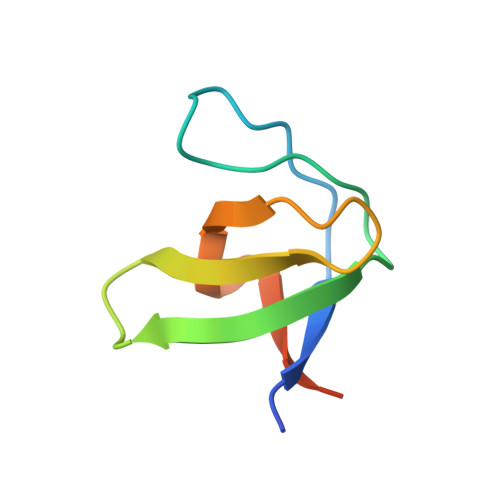Solution structure and peptide binding of the SH3 domain from human Fyn.
Morton, C.J., Pugh, D.J., Brown, E.L., Kahmann, J.D., Renzoni, D.A., Campbell, I.D.(1996) Structure 4: 705-714
- PubMed: 8805554
- DOI: https://doi.org/10.1016/s0969-2126(96)00076-7
- Primary Citation of Related Structures:
1NYF, 1NYG - PubMed Abstract:
The Src family of tyrosine kinases is involved in the propagation of intracellular signals from many transmembrane receptors. Each member of the family contains two domains that regulate interactions with other molecules, one of which is the Src homology 3 (SH3) domain. Although structures have previously been determined for SH3 domains, and ideas about peptide-binding modes have been proposed, their physiological role is still unclear. We have determined the solution structure of the SH3 domain from the Src family tyrosine kinase Fyn in two forms: unbound and complexed with a peptide corresponding to a putative ligand sequence from phosphatidylinositol 3' kinase. Fyn SH3 shows the typical SH3 topology of two perpendicular three-stranded beta sheets and a single turn of 3(10) helix. The interaction of SH3 with three potential ligand peptides was investigated, demonstrating that they all bind to the same site on the molecule. A previous model for ligand binding to SH3 domains predicts binding in one of two orientations (class I or II), each characterized by a consensus sequence. The ligand with the closest match to the class I consensus sequence bound with highest affinity and in the predicted orientation. The Fyn SH3 domain has a well-defined structure in solution. The relative binding affinities of the three ligand peptides and their orientation within the Fyn SH3 complex were consistent with recently proposed models for the binding of 'consensus' polyproline sequences. Although the affinities of consensus and non-consensus peptides are different, the degree of difference is not very large, suggesting that SH3 domains bind to polyproline peptides in a promiscuous manner.
- Oxford Centre for Molecular Sciences, UK.
Organizational Affiliation:















